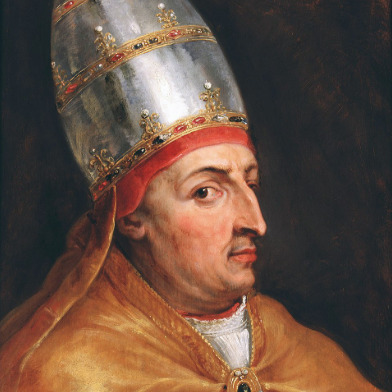#Pope Nicholas V
Explore tagged Tumblr posts
Text

I knew that the Catholic Church via the Pope had authorized slavery in the 1400s, but I didn’t know that they had authorized the eradication, subjugation, etc, of African people. Somehow I never connected the two.

“We grant you [Kings of Spain and Portugal] by these present documents, with our Apostolic Authority, full and free permission to invade, search out, capture, and subjugate the Saracens and pagans and any other unbelievers and enemies of Christ wherever they may be, as well as their kingdoms, duchies, counties, principalities, and other property […] and to reduce their persons into perpetual servitude.”
These clearly refers to the lands along the coast of West Africa. By these decree, Pope Nicholas V conceded to the King of Portugal Afonso V and Prince Henry and all their successors, all their conquests of Africa, and reduction to perpetual servitude of all people deemed non-believers and enemies of Christ, and all their properties.
A significant subsequent concession given by Nicholas V in a brief issued to King Alfonso in 1454 extended the rights granted to existing territories to all those that might be taken in the future. Together with a second reference to some who have already been enslaved, this has been used to suggest that Nicholas sanctioned the purchase of black slaves from “the infidel”: “… many Guineamen and other negroes, taken by force, and some by barter of unprohibited articles, or by other lawful contract of purchase, have been … converted to the Catholic faith, and it is hoped, by the help of divine mercy, that if such progress be continued with them, either those peoples will be converted to the faith or at least the souls of many of them will be gained for Christ.”
This bull is currently conserved at the Institute of the National Archives of Torre do Tomba in Lisboa, Portugal, under the reference PT/TT/BUL/0007/29 and is fully translated to French in the book “le Péché du pape contre l’Afrique” (The Sin of the Pope against Africa) (éd. Al qalam, Paris, 2002) de Assani Fassassi, P. 10 – 21.
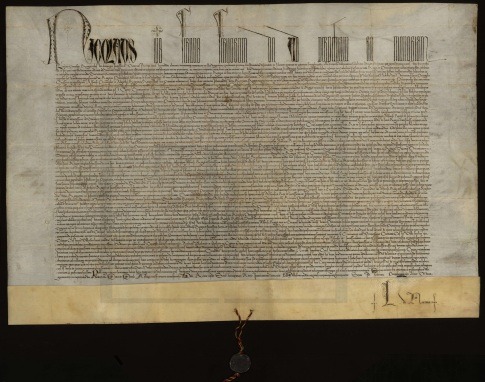
#catholics and slavery#pope nicholas v#dum diversas#Dum Diversas or The Vatican’s Authorization of Slavery#who started slavery of Africans#Enslaved Africans#catholic church is paying Reparations#Reparations
69 notes
·
View notes
Text
Reasons why pope Celestine V is a diva
1. Sent an letter to the cardinals saying "It's been 2 years since Nicholas IV died and if y'all don't elect a new pope soon God is gonna rock your shit"
2. Apparently tried to flee when the cardinals decided to make him pope, and it took THE KINGS OF HUNGARY AND NAPLES to persuade into accepting the position
3. Decreed that Pope's can resign
4. Resigned
541 notes
·
View notes
Text
TIL about Pope Celestine V.
In 1292, Nicholas IV died and the cardinals got together to figure out who'd be the next pope. They had some trouble coming to an agreement. By 1294 there was still no pope (this was obviously before the practice of locking them in the Sistine Chapel and not letting them out until they picked somebody).
It went on so long that nobody could avoid hearing about it, including actual cave hermits. One of these, literally a hermit who lived in a cave, found the situation annoying enough that he wrote the cardinals a letter warning that God would smite them if they didn't get the hell on with it. The cardinals replied, "okay, if you want a pope so bad, you do it!"
So they dragged this half-naked recluse out of his cave and put a mitre on him. You will be unsurprised to hear that it didn't go well. The new Pope Celestine V was terrible at politics (being a cave hermit is not a good way to develop people skills) and within a couple of months he was fed up and wanted to go back to his cave where nobody fucking bothered him. He decreed as pope that popes are allowed to resign - and then he did.
The cardinals were a little quicker to pick a replacement this time. Probably because this was when somebody invented the "you can't come out until there's a new pope" rule.
Celestine tried really hard to resume hermiting but was thwarted by a combination of bad luck and people who did not like his successor, Boniface VIII. He died (possibly murdered, but also around eighty so possibly just super old for a medieval guy) less than a year later, and ended up being made a saint. His corpse, dressed in pope clothes, is on display in a church in central Italy.
I'm pretty sure this would piss him off.
19 notes
·
View notes
Text
A question for Tumblr:
Explain your choice in the tags or comments, if you like!
12 notes
·
View notes
Note
Hello, I'm a Catholic who recently signed up for Tumblr and I unfortunately feel like I really did not understand what I was getting into with this website. For the last several weeks, I've been subjected to a campaign of internet stalking by a large gang of insidious thugs on this site. And I would brush it off as normal internet trolling, except that they seem to really know a lot about our faith!
The problem started a few weeks ago, when a "Tumblr famous" user known as "r4cs0" messaged me. He claims to be the closest living relative of Pope John Paul I, who died after only 33 days on the throne. When a Pope dies, the death must be verified by striking him three times in the head with a silver hammer. According to r4cs0, a church historian has recently examined the hammer used on John Paul I and learned it was only 87% silver. Per the canon laws of 1919, the hammer must be at least 90% silver to be considered true silver. Because of this and other "irregularities" regarding the death, r4cs0 insists that Pope John Paul I is still LEGALLY alive and still the Pope! And as his closest living heir, this makes r4cs0 the highest living authority in the Catholic Church until the corpse is exhumed and struck with the correct hammer!
Now if this isn't crazy enough, it gets worse. r4cs0 has written a Papal bull called In Tergo Intrantes. Of course it's in Latin so I can't read it, but r4cs0 says that it authorized certain Vatican authorities located in the Tower of Nicholas V to grant special dispensations to bi-sexual women who are seeking to enter into plural marriages, but only if they submit DNA samples to the Vatican Bank which prove they are free of any Asian heritage (this part has something to do with the Vatican agreement with the CCP). And I'm not even going to try to explain it, but after he told me this part of the story he suddenly went off on a tangent about how the Missing 411 series can be explained by extra-dimensional abductors hunting German people. I still can't figure out the connection, but it may have something to do with the Synod on Synodality.
But the point of all this is that "r4cs0," his allegedly bi-sexual girlfriend "tooiconic," and a large host of their followers have been tormenting me non-stop for the last several weeks. They say that when In Tergo Intrantes and Fiducia Supplicans are considered together, it obligates me to officiate a plural marriage they are planning to enter into with another Tumblr user named "takashi0" (who is a BRONY, just to make this whole thing even creepier). If I refuse, they claim they will call my bishop and have my actual marriage annulled by the church! I don't believe they can really do it, but they can certainly keep sending their followers to harass me! One of them called my boss at work today and started asking a bunch of questions about where he was when Catherine Cesnik was killed.
What do I do???
I’m going to kill you dude
17 notes
·
View notes
Note
Hello, I'm a Catholic who recently signed up for Tumblr and I unfortunately feel like I really did not understand what I was getting into with this website. For the last several weeks, I've been subjected to a campaign of internet stalking by a large gang of insidious thugs on this site. And I would brush it off as normal internet trolling, except that they seem to really know a lot about our faith!
The problem started a few weeks ago, when a "Tumblr famous" user known as "r4cs0" messaged me. He claims to be the closest living relative of Pope John Paul I, who died after only 33 days on the throne. When a Pope dies, the death must be verified by striking him three times in the head with a silver hammer. According to r4cs0, a church historian has recently examined the hammer used on John Paul I and learned it was only 87% silver. Per the canon laws of 1919, the hammer must be at least 90% silver to be considered true silver. Because of this and other "irregularities" regarding the death, r4cs0 insists that Pope John Paul I is still LEGALLY alive and still the Pope! And as his closest living heir, this makes r4cs0 the highest living authority in the Catholic Church until the corpse is exhumed and struck with the correct hammer!
Now if this isn't crazy enough, it gets worse. r4cs0 has written a Papal bull called In Tergo Intrantes. Of course it's in Latin so I can't read it, but r4cs0 says that it authorized certain Vatican authorities located in the Tower of Nicholas V to grant special dispensations to bi-sexual women who are seeking to enter into plural marriages, but only if they submit DNA samples to the Vatican Bank which prove they are free of any Asian heritage (this part has something to do with the Vatican agreement with the CCP). And I'm not even going to try to explain it, but after he told me this part of the story he suddenly went off on a tangent about how the Missing 411 series can be explained by extra-dimensional abductors hunting German people. I still can't figure out the connection, but it may have something to do with the Synod on Synodality.
But the point of all this is that "r4cs0," his allegedly bi-sexual girlfriend "tooiconic," and a large host of their followers have been tormenting me non-stop for the last several weeks. They say that when In Tergo Intrantes and Fiducia Supplicans are considered together, it obligates me to officiate a plural marriage they are planning to enter into with another Tumblr user named "takashi0" (who is a BRONY, just to make this whole thing even creepier). If I refuse, they claim they will call my bishop and have my actual marriage annulled by the church! I don't believe they can really do it, but they can certainly keep sending their followers to harass me! One of them called my boss at work today and started asking a bunch of questions about where he was when Catherine Cesnik was killed.
What do I do???

I am, wow, I don't have words. Wow. Just keep blocking them and try to remove any personal information from your blog
Important update: it's all fake apparently
#i have an annoying tendency to take everything seriously so if this was just a joke i apologize#but if its not#😬😬😬😬
31 notes
·
View notes
Text


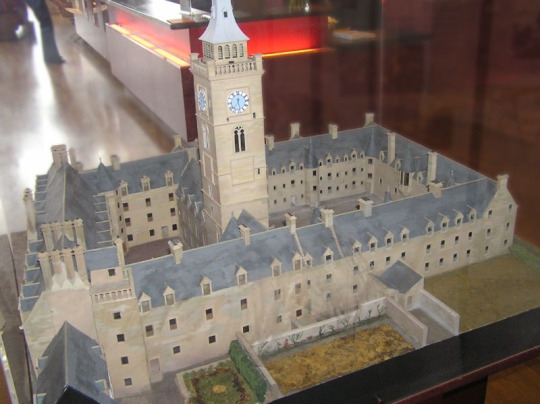





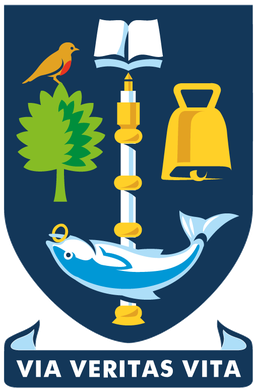

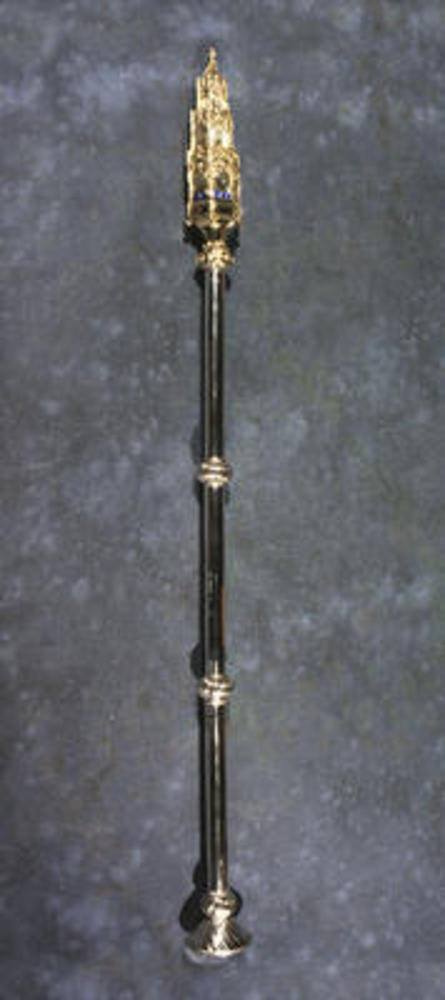


On January 7th 1451 a Papal Bull from Pope Nicolas IV enabled the foundation of Glasgow University.
Today The University is 574 years old and is the second oldest University in Scotland after St Andrews.
Now housed mainly in Glasgow's West End the origins on the institution however lie in the city's oldest street, in the Merchant City.
The university was inaugurated in 1451 at the request of William Turnbull, Bishop of Glasgow after a Papal Bull was issued by Pope Nicholas V. It was part of King James II's plan to bring Scotland up to speed with England – which already had two universities, Oxford and Cambridge.
The original Bull was among the treasures of the Metropolitan See taken to France by Archbishop Beaton at the Reformation but the modern University retains a transcript made in 1490. Beaton also took with him the University mace which had been made in 1465. Unlike other treasures, this was recovered and returned to the University 30 years later, and is still in its possession today.
Lectures were originally held in Glasgow Cathedral, before moving to nearby buildings on the city's High Street in 1457.
In 1563, Mary, Queen of Scots granted the university a 13-acre site on Glasgow's High street that had, until the Reformation, been home to a Dominican (Blackfriars) friary. The Old College ran along the busy High Street, with a main gateway in its centre that led through to two courtyards and walled gardens.
But as student numbers rocketed, the university was force to sell up their Old College campus and move somewhere cheaper. In 1863 it was bought for £100,000 to the City of Glasgow Union Railway Company, to be used as a goods yard. It was later demolished and housing was built there instead.
The decision was heavily criticised at the time as an act of "cultural vandalism." Nevertheless, the Uni heading west to Gilmorehill – away from the polluted air and the hustle and bustle of the city.
Work started on the new site in the west end in 1866, with the university taking up official residence in 1870.
Prolific architect George Gilbert Scott undertook the grand task of designing the new University buildings – which were the biggest in Britain beside the Houses of Parliament at the time.
The decision not to open up the commissioning process to other designers was met with controversy… Not to mention Scott's Gothic style went against the grain of the architectural landscape of the city, which ventured towards a Greek design.
According to Glasgow Uni's website, esteemed architect Alexander 'Greek' Thomson was not too impressed. He complained Scott wouldn't pay the project the attention it deserved because of how busy he was in his career.
He also added: "There is not a modern Gothic revival building of more than ten years standing that any one cares a straw about." Meoooow.
Nevertheless, Scott pressed on - building one of the most striking landmarks in the west end. The Bute and Randolph halls were completed after Scott's death in by his son Oldrid in 1891, which also included the Gothic bell tower, which stands at 278 feet high.
The Lion and Unicorn staircase was also famously moved, brick by brick, to Gilmorehill – now leading into the west wing of the main building beside the University Chapel.
Pearce Lodge, which sits at the bottom of University Avenue, is also formed by various parts of the Old College buildings. The stonework entrance to the original High Street building was also carefully erected at the gatehouse of the new campus.
The university expanded further over the years – including the A-listed reading room in the 1930s. It also snapped up a number of Victorian terraced houses, where the departments of Psychology, Computing Science and most of the Arts Faculty are based. Elsewhere. the leafy Garscube estate was bought in 1947 for The Veterinary Sciences school in Bearsden.
So, next time you see that regal clock tower and spire looming against the west end skyline, you can remember Glasgow Uni's journey across the city to its rightful place.
To find out more about the history of Glasgow University, visit their website.
8 notes
·
View notes
Note
Hello, I'm a Catholic who recently signed up for Tumblr and I unfortunately feel like I really did not understand what I was getting into with this website. For the last several weeks, I've been subjected to a campaign of internet stalking by a large gang of insidious thugs on this site. And I would brush it off as normal internet trolling, except that they seem to really know a lot about our faith!
The problem started a few weeks ago, when a "Tumblr famous" user known as "r4cs0" messaged me. He claims to be the closest living relative of Pope John Paul I, who died after only 33 days on the throne. When a Pope dies, the death must be verified by striking him three times in the head with a silver hammer. According to r4cs0, a church historian has recently examined the hammer used on John Paul I and learned it was only 87% silver. Per the canon laws of 1919, the hammer must be at least 90% silver to be considered true silver. Because of this and other "irregularities" regarding the death, r4cs0 insists that Pope John Paul I is still LEGALLY alive and still the Pope! And as his closest living heir, this makes r4cs0 the highest living authority in the Catholic Church until the corpse is exhumed and struck with the correct hammer!
Now if this isn't crazy enough, it gets worse. r4cs0 has written a Papal bull called In Tergo Intrantes. Of course it's in Latin so I can't read it, but r4cs0 says that it authorized certain Vatican authorities located in the Tower of Nicholas V to grant special dispensations to bi-sexual women who are seeking to enter into plural marriages, but only if they submit DNA samples to the Vatican Bank which prove they are free of any Asian heritage (this part has something to do with the Vatican agreement with the CCP). And I'm not even going to try to explain it, but after he told me this part of the story he suddenly went off on a tangent about how the Missing 411 series can be explained by extra-dimensional abductors hunting German people. I still can't figure out the connection, but it may have something to do with the Synod on Synodality.
But the point of all this is that "r4cs0," his allegedly bi-sexual girlfriend "tooiconic," and a large host of their followers have been tormenting me non-stop for the last several weeks. They say that when In Tergo Intrantes and Fiducia Supplicans are considered together, it obligates me to officiate a plural marriage they are planning to enter into with another Tumblr user named "takashi0" (who is a BRONY, just to make this whole thing even creepier). If I refuse, they claim they will call my bishop and have my actual marriage annulled by the church! I don't believe they can really do it, but they can certainly keep sending their followers to harass me! One of them called my boss at work today and started asking a bunch of questions about where he was when Catherine Cesnik was killed.
What do I do???
Call him a Heretic and buy a gun for self defense. Then notify the proper authorities, that being the actual Vatican. I'm certain his Holiness will have something to say on the matter.
7 notes
·
View notes
Text
Holidays 11.13
Holidays
Actor’s Day
Advocacy Action Day
Blame Someone Else Day
Brassiere Day
Canterbury Day (New Zealand)
Caregiver Appreciation Day
Day of Radiological, Chemical and Biological Defense Troops (Russia)
Geographic Information Systems Day
International Day of Huntington’s Disease
International Schinzel-Giedion Syndrome Awareness Day
Lhabab Duechen (Bhutan)
Madder Day (French Republic)
Mister Rogers Cardigan Day
National Community Education Day
National Dream Destination Day
National Hug a Musician Day
National Japanese Culture Day
National Mom’s and Dad’s Day
National Reread Old Letters and Magazines Day
National Saddle Hunting Day
National Sunflower Day (South Africa)
Njegos Day (Montenegro)
Odd Couple Day
Odd Socks Day (UK)
Quasihomosexual Pride Day
Sadie Hawkins Day [also 11.15 & 1st Saturday]
Start a Rumor Day
Swiftie Day
Symphonic Metal Day
Tree Festival Day (Tunisia)
Tree Day (Macedonia)
World Kindness Day
Food & Drink Celebrations
Frankfurter Day
Indian Pudding Day
National Bread Pudding Day
National Chicken Nugget Day
National Roast Dinner Day (UK)
National Sea Salt Caramel Day
World Mediterranean Diet Day
Independence & Related Days
Politzania Independence Day (Klaatu)
2nd Wednesday in November
Blue Wednesday [2nd Wednesday]
Buß- und Bettag (Day of Repentance and Prayer; Bavaria, Saxony) [2nd Wednesday before 1st Sunday in Advent]
Hump Day [Every Wednesday]
International Pathology Day [2nd Wednesday]
National CTEPH Awareness Day [2nd Wednesday]
Wacky Wednesday [Every Wednesday]
Watermelon Wednesday [2nd Wednesday of Each Month]
Website Wednesday [Every Wednesday]
Workout Wednesday [2nd Wednesday of Each Month]
Weekly Holidays beginning November 13 (2nd Full Week of November)
Geography Awareness Week (thru 11.17)
World Kindness Week (thru 11.19) [Week Starting 11.13]
Festivals Beginning November 13, 2024
Cairo International Film Festival (Cairo, Egypt) [thru 11.22]
Country Living Christmas Fair (London, United Kingdom) [thru 11.16]
Rock the Bells Cruise (Miami, Florida) [thru 11.17]
Feast Days
Abbo of Fleury (Christian; Saint)
Agostina Livia Pietrantoni (Christian; Saint)
Arcadius and His Companions (Christian; Martyrs)
Barneveldt (Positivist; Saint)
Benny Andrews (Artology)
Bertel Thorvaldsen (Artology)
Brice of Tours (Christian; Saint)
Charles Simeon (Church of England)
Chillen (a.k.a. Killian; Christian; Saint)
Chuang Tzu’s Day
Constant (Christian; Saint)
Cranberry Sparkle Cake Day (Starza Pagan Book of Days)
The Dangerous Dragon (Muppetism)
Death-Watch (Celtic Book of Days)
Didacus (Diego) of Alcalá (Christian; Saint) [Cooks]
Epulum Iovis (Festival of Feronia, Juno, Minerva and Jupiter; Ancient Rome)
Eugenius II of Toledo (Christian; Saint)
Feast of Feronia (a.k.a. Epulum Iovis; Old Etruscan and Roman Fertility Goddess)
Feast of Hundred Thousand Martyrs of Tbilisi (Georgia)
Feast of the Saints of the Premonstratensian Order (Roman Catholic)
Festival of Feronia (Ancient Roman Goddess of Wildlife, Fertility, Health & Abundance)
Festival of Jupiter (Ancient Rome)
Fontinalia (Festival to Fons, Spirit of Springs; Pagan)
Fortuna Primigenia (Fortune of the Firstborn; Ancient Rome)
Frances Xavier Cabrini (Christian; Saint)
George V. Higgins (Writerism)
Homobonus (Christian; Saint)
The Hundred Thousand Martyrs of Tbilisi (Georgian Orthodox Church)
Ides of November (Ancient Rome)
John Chrysostom (Eastern Orthodox, Repose)
Kilian (Christian; Saint)
Leandro (Christian; Saint) [Spain]
Maxellendis (Christian; Virgin & Martyr)
Mitrius (Christian; Saint)
Nicholas I, Pope (Christian; Saint)
Otis Campbell Day (Church of the SubGenius; Saint)
Quintian of Rodez (Christian; Saint)
Rivkah (Artology)
Robert Louis Stevenson (Writerism)
Saints of the Benedictine family (Christian; Saints)
Saints of the Premonstratensian Order (Christian; Saints)
Stanislaus Kostka (Christian; Saint)
Stephen Baxter (Writerism)
Talk to Birds Day (Pastafarian)
Tooth Collection Days begin (Fairies; Shamanism)
William Gibson (Writerism)
Lucky & Unlucky Days
Butsumetsu (仏滅 Japan) [Unlucky all day.]
Day of Darkness, Evil & Misfortune (Medieval Europe) [13th Day after Halloween)
Prime Number Day: 317 [66 of 72]
Premieres
Aladdin (Animated Disney Film; 1992)
An Arrow Escape (Terrytoons Cartoon; 1936)
Beauty Shoppe (Ub Iwerks Cartoon; 1940)
Bram Stoker’s Dracula (Film; 1992)
The Bush Pusher or Beri Beri Who’s Got the Berry? (Rocky & Bullwinkle Cartoon, S4, Ep. 178; 1962)
Caroline Lamb (Writerism)
Double Danger (Animated TV Show;Jonny Quest #9; 1964)
Downhearted Duckling (Tom & Jerry Cartoon; 1954)
Enough Stupidity in Every Wise Man, by Aleksandr Ostrovsky (Play; 1868)
Fantasia (Animated Disney Film; 1940)
Fantastic Mr. Fox (Stop Motion Film; 2009)
The Forty Thieves (Terrytoons Cartoon; 1932)
Hairied and Hurried (WB MM Cartoon; 1965)
Heart of Darkness, by Joseph Conrad (Novel; 1902)
Laundry Service, by Shakira (Album; 2001)
Laura, by Vera Caspary (Novel; 1942)
The Lightning Bugs or Nuts and Volts (Rocky & Bullwinkle Cartoon, S4, Ep. 177; 1962)
The Line, The Cross & The Curve, by Kate Bush (Short Film; 1993)
Lionheart, by Kate Bush (Album; 1978)
Lose Yourself, by Eminem (Song; 2002)
Mountain Mover or Boris Sneaks a Peak (Rocky & Bullwinkle Cartoon, S2, Ep. 72; 1960)
An Old-Fashioned Love Song, by Three Dog Night (Song; 1971)
1, by The Beatles (Compilation Album; 2000)
Out of the Past (Film; 1947)
Out of This Whirl (Noveltoons Cartoon; 1959)
Porky’s Double Trouble (WB LT Cartoon; 1937)
Rocky and the Rock or Braver and Boulder (Rocky & Bullwinkle Cartoon, S2, Ep. 71; 1960)
The Saint in Pursuit, by Fleming Lee (Short Stories; 1970) [Saint #43]
Scooby-Doo and the Reluctant Werewolf (Hanna-Barbera Animated TV Movie; 1988)
A Short History of Decay, by Emil M. Cioran (Science Book; 1949)
Silent Night, recorded by Bing Crosby (Song; 1935)
Ski for Two (Woody Woodpecker Cartoon; 1944)
2012 (Film; 2009)
War and Remembrance (TV Mini-Series; 1988)
Where the Wild Things Are, by Maurice Sendak (Children’s Book; 1963)
Whistler’s Father, Parts 1 & 2 (Underdog Cartoon, S2, Eps. 33 & 34; 1965)
Yellow Submarine (Animated Film; 1968)
Today’s Name Days
Eugen, Livia, Stanislaus (Austria)
Brcko, Brickije, Didak, Dobroslav, Homobonus, Ivan, Mitar, Stanislav, Stanko (Croatia)
Tibor (Czech Republic)
Arcadius (Denmark)
Krister, Kristjan, Kristo, Risto (Estonia)
Ano, Kristian (Finland)
Brice (France)
Eugen, Livia, Stanislaus, Rene (Germany)
Chrysostomos, Damaskinos, Hrysostomos (Greece)
Szilvia (Hungary)
Brizio, Diego, Omobono, Paterniano (Italy)
Eižens, Jevgēņija, Jevgēņijs, Taida (Latvia)
Arkadijus, Eirima, Norvydas (Lithuania)
Kirsten, Kirsti (Norway)
Arkadiusz, Arkady, Brykcjusz, Eugeniusz, Jan, Mikołaj, Stanisław, Walentyn (Poland)
Ioan (România)
Stanislav (Slovakia)
Diego, Leandro (Spain)
Krister, Kristian (Sweden)
Brice, Bruce, Bryce, Bryson, Stan, Stanford, Stanley (USA)
Today is Also…
Day of Year: Day 318 of 2024; 48 days remaining in the year
ISO: Day 3 of Week 46 of 2024
Celtic Tree Calendar: Hagal (Hailstone) [Day 18 of 28]
Chinese: Month 10 (Yi-Hai), Day 13 (Xin-Si)
Chinese Year of the: Dragon 4722 (until January 29, 2025) [Wu-Chen]
Hebrew: 12 Heshvan 5785
Islamic: 11 Jumada I 1446
J Cal: 18 Wood; Threesday [18 of 30]
Julian: 31 October 2024
Moon: 93%: Waxing Crescent
Positivist: 10 Frederic (12th Month) [Gustavus Adolphus]
Runic Half Month: Nyd (Necessity) [Day 7 of 15]
Season: Autumn or Fall (Day 52 of 90)
Week: 2nd Full Week of November
Zodiac: Scorpio (Day 21 of 30)
3 notes
·
View notes
Text
The Retired Colourman
Published in 1926, this was placed last in the Case-book compilation, although it was not the last Holmes story Doyle published. That is "Shoscombe Old Place", which we have yet to cover.
A colourman is someone who makes and sell paint. The term is very little used these days.
Lewisham is a London suburb located six miles from Charing Cross; it had transferred from Kent to London in the 1889 creation of the London County Council and today forms its own London Borough.
The Coptic Pope at the time was Cyril V, who reigned from 1874 to 1927, the longest serving head of the Coptic Orthodox Church.
The Theatre Royal Haymarket was opened in 1720 and remains in use today as a theatre. It's currently running a production of Noises Off and next year will play host to The Picture of Dorian Gray, which is going to see Sarah Snook play all 26 roles.
Blackheath is a suburban station today served by electric trains operated by Southeastern from Victoria, Charing Cross and Cannon Street.
Lothario dates back to Don Quixote as a name, but its use for a serial seducer of women comes from the 1703 Nicholas Rowe play The Fair Penitent.
Crockford's Clerical Directory is a book listing clergy in the UK and Ireland.
Little Purlington is fictitous, but Frinton is real. Now Frinton-on-Sea, it is located on the Essex coast and by 1927 was attracting regular high society visitors. Former residents of note include Deborah Watling, who played Victoria Waterfield in Doctor Who. Due to its reputation as a place to retire to, it became the subject of a common joke "Harwich for the Continent, Frinton for the incontinent", the former being an LNER advertising slogan. Probably not a good idea to make that gag locally though.
Third Class trains had originally been ones with wooden seating, but by this time, Second Class had been abolished and the former passengers were now generally in upholstered carriages. Third Class became Second Class in 1956 on British Railways and is now Standard Class.
I have been unable to find when cyanide pills became a thing. Doing a search for them gives you the number of a suicide prevention line first, which is quite reasonable.
Broadmoor is a high-security psychiatric hospital in Berkshire, completed in 1863. Notable patients have included Ronald 'Ronnie' Kray, 'Yorkshire Ripper' Peter Sutcliffe and Edward Oxford, a barman who tried to kill Queen Victoria. Until 2018, it maintained sirens to be used in case of an escape.
29 notes
·
View notes
Note
are the lord bishops different than the cardinals from the pope story?
Hi, Nony! Good question!! 😊 (apologies for the delay)
Yes, the Lord bishops are different than the Cardinal bishops.
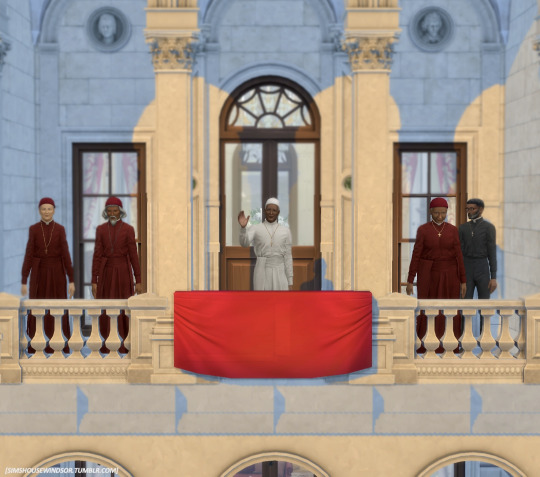
Francis Benedict XVI, the Holy Pope, is Chief Pastor of the worldwide Cathlosim Church and Head of The State of King’s City in San Myshuno. The Vatisim Palace in the State of King's City is the official residence of the Pope of the Cathlosim Church.
Cardinals
The Cardinals are senior member of the clergy of the Cathlosim Church. Cardinals are created by the pope and typically hold the title for life. In 1886, Pope Flouris V limited the number of cardinals to 60: [3] five cardinal bishops, 40 cardinal priests, and 15 cardinal deacons.
The most solemn responsibility of the cardinals is to elect a new pope in a conclave, almost always from among themselves (with a few historical exceptions), when the Holy See is vacant. During the period between a pope's death or resignation and the election of his successor, the day-to-day governance of the Holy See is in the hands of the College of Cardinals.
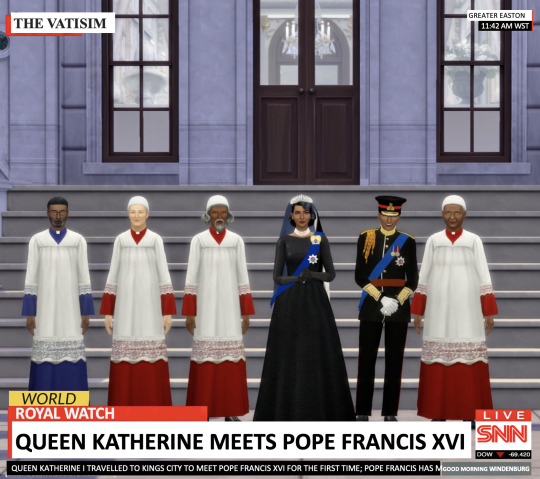
above photo from "pope" story here
Cardinal bishops
Cardinal bishops are the senior order of cardinals. For most of the second millennium there were five cardinal bishops, each presiding over one of the six suburbicarian sees around San Myshuno: Franklen, San Bebinbur, Port Simia, Milletosa, and Ilbutrid.
There are currently 3 Cardinal bishops. The Dean of the College of Cardinals, Abraham Criste, Cardinal Walter Tesmond and Cardinal Luke Nicholas. There is 1 Camerlengo, Benjamin Carmichael III.

Queen Katherine I, the Sovereign, is Head of the Church of Windenburg. Buckingsim Palace in Buckingsimshire, Windenburg is the official residence of the monarch.
Bishops
The Church of Windenburg has a legislative body, General Synod. The most senior bishop of the Church of Windenburg is the Archbishop of Calgary. The second most senior bishop is the Archbishop of York. The Bishops of Easton and Henford are ranked in the next two positions, and as the holders of those sees they automatically become ex-officio members of the House of Lords.
The process of appointing bishops is complex, due to historical reasons balancing hierarchy against democracy, and is handled by the Crown Nominations Committee which submits names to the Prime Minister (acting on behalf of the Crown) for consideration.
Of the 57 archbishops and bishops in the Church of Windenburg, 5 are permitted to sit in the House of Lords.
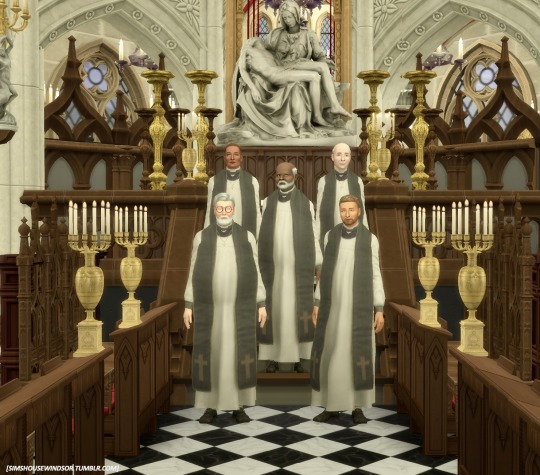
Lord bishops
There are 5 bishops of the Church of Windenburg who sit in the House of Lords, which is the Second Chamber of the United Kingdom Parliament. Known as the Lord Bishops, they read prayers at the start of each daily meeting and play a full and active role in the life and work of the House.
Lord bishops sit as individual and independent Members of the House of Lords, similarly to the independent Crossbench Peers and those who are not party-affiliated.
Lord bishops provide an important independent voice and spiritual insight to the work of the House and, while they make no claims to direct representation, they seek to be a voice for all Sims of faith, not just Christians.
Thanks for the ask!! 💜
10 notes
·
View notes
Text

Matilda of Hainaut (November 1293 – 1331), also known as Maud and Mahaut, was Princess of Achaea from 1316 to 1321. She was the only child of Isabella of Villehardouin and Florent of Hainaut, co-rulers of Achaea 1289–1297. After Florent's death in 1297, Isabella continued to rule alone until she remarried to Philip of Savoy in 1300. Per arrangements made with King Charles II of Naples, Isabella was not allowed to marry without his consent and after Philip failed to adequately participate in the king's campaigns against Epirus, Charles in 1307 revoked their rights to Achaea. Matilda, just fourteen years old, tried to press her claim as their heir but was refused by the bailiff Nicholas III of Saint Omer, who instead chose to wait for orders from Naples. Shortly thereafter, Charles appointed his favorite son, Philip of Taranto as the new Prince of Achaea.
Philip of Taranto spent little time in Greece and appointed as his bailiff Guy II de la Roche, Matilda's husband. Guy did not last long in this position, dying in 1308. Matilda was then betrothed by Philip of Taranto to his eldest son, Charles of Taranto. In 1313, this betrothal was broken off and Matilda was married to Louis of Burgundy as compensation to the House of Burgundy due to Philip of Taranto in the same year having married Catherine of Valois, previously betrothed to Hugh V, Duke of Burgundy. Philip of Taranto also renounced his rulership of Achaea and bestowed the Principality of Achaea on Matilda and Louis. Before they had travelled to their new domain, Achaea was seized in 1315 by the usurper Ferdinand of Majorca. Matilda and Louis landed in Achaea in early 1316 and secured control of the principality after the defeat and death of Ferdinand in the Battle of Manolada. Their co-rule did not last long; Louis died less than a month later, widowing Matilda for the second time.
The new king of Naples, Robert, wished to exploit Matilda's uncertain position to gain the principality back for his family. In 1317, he proposed that Matilda should marry his brother, John of Gravina. Matilda refused as she did not wish to enter into a third political marriage. In 1318, Robert's emissaries abducted the princess and brought her to Naples by force. She was forced to go through a marriage ceremony with John, but she refused to recognize him as her husband. In 1321, Matilda was dragged in front of Pope John XXII who ordered her to obey Robert and marry John, but she still refused. Matilda then confessed that she had secretly married the knight Hugh de la Palisse. No more attempts were made to marry her to John but Robert could now revoke Achaea from her control as she had married without his consent. Robert also fabricated a story that Hugh had made an attempt on his life, and that Matilda was his accomplice, and used this as an excuse to imprison the princess. Matilda spent the rest of her life as a prisoner, first in the Castel dell'Ovo in Naples and then in Aversa, where she died in 1331.
3 notes
·
View notes
Text
On 26 July [1535], Pope Paul issued a decree in the Consistory condemning Henry as a heretic and schismatic, and depriving him of his kingdom. Christian princes were ordered to shun him but the [King and Queen], then out daily hunting and hawking, were unperturbed. With Charles [V] keeping everybody in Italy fully occupied, Rome had no chance of enforcing the decree. Throughout July, August, and September, Henry and Anne were happy together, feasting, making love, entertaining guests, honouring those who had voted for the royal supremacy and Treason Act in Parliament and paying them visits. When on the road towards Bristol, Will Somer, the king's inexperienced new fool, attempted 'ribald jests' at Anne's and her daughter's expense, Henry physically attacked him. Somer fled for his life, taking refuge with Nicholas Carew at his house in Beddington until the king calmed down.
Hunting the Falcon: Henry VIII, Anne Boleyn & the Marriage That Shook Europe, John Guy & Julia Fox
#just. dropping that in there#'his majesty has never signed fewer documents' wbk.#julia fox#john guy#henrician#henry viii#anne boleyn
8 notes
·
View notes
Text

THE DESCRIPTION OF SAINT BERNARDINE OF SIENA The Patron of Advertising and Respiratory Ailments Feast Day: May 20
"The last degree of love is when He gave Himself to us to be our Food; because He gave Himself to be united with us in every way."
Bernardino of Siena, was born in Massa Marittima, Republic of Siena, Holy Roman Empire, on the Feast of the Nativity of Mary - September 8, 1380. Having lost both parents at an early age, he was educated by a maternal aunt, who taught him the fear of the Lord.
At 17, he joined the Confraternity of Our Lady, whose members pledged themselves to relieve the sick. Seven years later, he entered the 'Franciscans of the Strict Observance' near Siena, where he was ordained. After 12 years of study and meditation, a novice unexpectedly shouted: 'Brother Bernardine! Hide no longer the gift that is in you.'
His superiors considered it a call from above and sent Bernardine to preach throughout Italy. Bernardine's eloquence and zeal attracted enormous congregations. He said that: 'The name of Jesus is the glory of the preachers.'
And used to bless the people at the end of every sermon with the Holy Name of Jesus written on a tablet. It was inscribed with the three letters, IHS, signifying: 'Iesus Hominum Salvator', translated as 'Jesus, Savior of Men.'
In Bologna, he preached so efficiently that the people brought their gambling cards to be burnt in a public bonfire. A card-manufacturer who complained that he was deprived of his livelihood was told by the saint to manufacture tablets inscribed with the Holy Name. The demand was so great that he became rich. Bernardine was urged to become bishop several times, but he was refused in order to continue his missionary work.
In 1430, being elected vicar general of the Observant Franciscans, he warned the friars about the dangers of ignorance, and included the study of Theology and Canon Law in their regular formation.
He died on May 20, 1444 at the age of 63 in Aquila, Kingdom of Naples, Holy Roman Empire, beatified on November 24, 1449, and was canonized six years later on May 24, 1450 by Pope Nicholas V.
#random stuff#catholic#catholic saints#bernardine of siena#bernardino of siena#bernardino de siena#franciscans#advertising#respiratory ailments
2 notes
·
View notes
Text
The third battle of Centro ( 16/02/79)

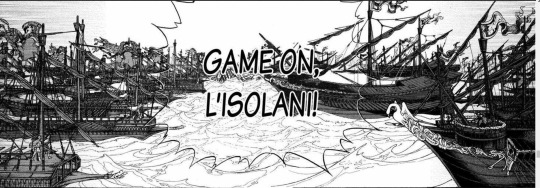
The Third Battle of Centro, also known as the Phoenician War, was fought on the 16th of the month of Tencere, in the year 79 CTR, between a combined fleet consisting of the Knights of Rhodes, Sicilia, Naples, Genoa, Balt Rhein, and Li'solani, against the fleet of the Turkiye-Venedik alliance in the sea of Centro, near the city of Phoenicia. This was the third round of fighting in the entire conflict at sea between the two powers, in an attempt by the Imperial and Crusader alliances to dominate the waters of Centro after the failure of the land invasion of Sud. The Turkiye-Venedik fleet won a landslide victory, killing many of the Crusaders' commanders, capturing most of their warships, and taking many prisoners and booty. This battle was the end of the Balt Rhein Empire's dominance of the Centro and the loss of its vassal state on the island of Crete. It also had a major impact on the first appearance of the Turkiye naval dominance as the new ruler of the Centro Seas.
Power map of Balt Rhein Turkiye after the battle of Cinza.
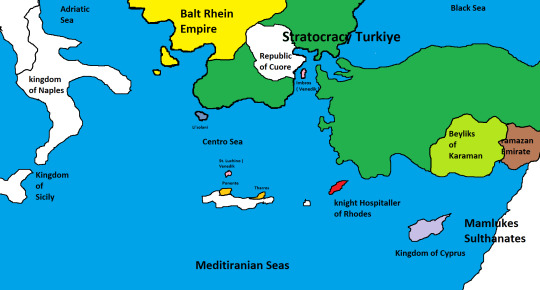
several Countries in Centro and Mediterranean Before a Battle.
Prime Minister Louis of Balt Rhein was still not giving up his passionate determination to continue fighting Turkiye. even though the expeditionary force sent to Sud was destroyed. while according to miller, (who argues that the expedition to Sud was not at the direction of St Michael) Louis once again used his bet to be able to take Sud by sea. His strategy was to cut off all Turkiye lines of communication and supplies by taking control of Centro so that he could directly threaten Imbros (a Venedic colony) and Constantinople. Louis mediated with Pope Nicholas V to organise another Crusade. Despite Rome's difficulties in mobilising the masses, due to internal conflicts in western Europe, the pope's invitation was successful in getting Genoa, Sicily, Naples and the Hosipitaller Knights of Rhodes to form an alliance.
On 22 Lale, 79 CTR, the Naples and Sicily Fleets of 100 galleys each besieged Li'solani. Donattello Doria immediately surrendered, and asked for security guarantees. even offered military assistance in order to fight the Türkiye and Venedik. thus, Li'solani broke out of his agreement with the Türkiye 2 years ago that they had signed themselves. Donatello's betrayal reached the venedik and received a strong reaction from Antonio Lucio, Doge Venedik. Antonio conveyed this news directly to Constantinople. in response to this Zaganos Pasha ordered careful military preparations to Hamza Pasha as the Kapudan Bahriye who was positioned in Phoenicia. in order to mobilise his fleet.
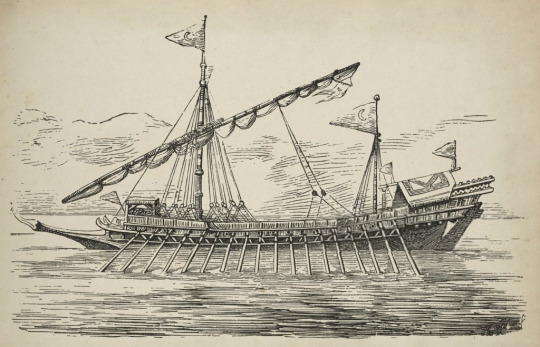
Turkiye Galleys in 15th Century
In addition to taking control of Li'solani, the crusader fleet attacked any ship passing through the western centro. It did not even distinguish which ships belonged to Turkiye from those belonging to their own allies. On the 28th, there was an incident of robbery of a venedic merchant ship by the crusader fleet. The raids expanded to reach Ponente, Tharos, and St. Lucino. The two countries on the island of Crete decided to submit to the crusaders. facing the worsening situation in Centro. Antonio Lucio decided to make military preparations. The levy of goods was increased, and soldiers and archers were recruited. Marco Quirini, one of the Venedic commanders who participated in the first Centro War, was appointed Commander in Chief in place of Silvestro Brega. at the head of the Venedic Fleet mobilised in Imbros, consisting of 150 galleys.

Various Types of Venetian Ships
On the 3rd of Tencere, Hamza Pasha ordered the addition of 150 galleys in Phoenicia and immediately accelerated the mobilisation. With this new navy, Hamza Pasha tried to get out of Phoenike Harbour and met a small part of the crusader fleet that was coincidentally trying to get closer to Phoenike for the sake of looting. A brief battle ensued, and Hamza Pasha was able to repulse the invaders' attack. From this brief battle, Hamza Pasha realised that it seemed that the crusaders were attacking without any coordination or prepared strategy. So there was a possibility of winning the battle.
The next day, the Balt Rhein Imperial Fleet, led by Andreas Patarini, left the vessels for Li'solani, where the Crusader Fleet was supposed to be assembled. In the evening, a council of war was held. A dispute ensued over who would command the combined Crusader Fleet. Andreas put himself forward to lead the fleet. However, the majority of the Sicilian and Genoese forces voted against him. The Genoese instead put forward Giustiniani (their warlord, who was rumoured to have disappeared after the battle of Gallipoli, 77 CTR) to lead their leet. It is known that Giustiniani did not die and managed to survive his humiliating defeat and escape to Rhodes. Giustiniani is currently on his way to lead the Hospitaller Knight Fleet to Li'solani to answer the call of the papal alliance.
However, the Giustiniani's arrival was very slow due to a westerly wind that was contrary to the direction they were travelling. Five days later, on Tencere 8, Giustiniani arrived at Li'solani and immediately convened the council of war once again. Provveditore Venier (Capitan of Naples), Albano Capello (Genoa), and Poei Manfredi (Li'solani) urged a direct attack on the Turkishye Venedik forces towards their headquarters, i.e., Phoenicia, given that both fleets were not yet fully organised. But Giusitiniani was hesitant about this proposal and preferred to target an easier target, i.e., the city of Chielo or the city of Scoglio. This proposal was supported by the commanders of the Balt Rhein. The crusader commander accused the Balt Rhein of greed and stubbornness, wanting only the result of the war for themselves. The division among the councils of war continued into the night. Nevertheless, Giustiniani finally supported the first opinion. and decided to reorganise his fleet, getting ready to face the Combined Turkiye-Venedik Fleet.
Battle
The fleet of the Crusader Alliance, consisting of 400 ships (according to Marino Satino), 200 galleys from Balt Rhein, 40 from Rhodes, 30 from Li'solani, 80 from Sicily, 30 from Genoa, and 20 from Naples. (Among all the ships, those of Genoa and Naples were the largest.) The movement of the Crusader fleet towards the battlefield was very slow due to the lack of wind. and the fleet only departed on the 12th. Meanwhile, the Venedic Turkiye Combined Fleet arrived in Phoenicia, consisting of 300 ships. The Turkish ships were dominated by small galleys (and no large ships), totaling 150 galleys. supported by the Venedic Fleet (100 Galleys, 20 Formosse, and 30 Mescolare). Hamza Pasha was appointed Commander-in-Chief of the Combined Fleet. and prepared to organise his battle formation. upon hearing that the Crusader Fleet was moving towards Phoenicia.
The two fleets met on the Phoenicia Sea Route on the 16th. Seeing that the enemy forces had more fleets and larger ships, Hamza Pasha decided to face his galleys against the galleys of the Balt Rhein and Rhodes. while the Venedic forces faced the Genoese, Naples, and Li'solani. The two ships approached each other and began to fire arrows. Hamza Pasha arranged the formation of his galleys close to the enemy galleys so as to make it easier for his soldiers to fight each other, like a war on land. The war continued with mutual sword-slashing and arrow-shooting for a long time, turning into a frightening, bloody battle. The Imperial troops tried to break free from the oars of the Turkiye galleys. However, the two galleys had already docked and could not be released. Despite the bumpy and unstable tidal waters, the Turkiye troops were able to take control of the situation. and killed many of the Empire's marine troops. The Balt Rhein troops were in disarray as their commander, Andreas Patarini, was killed, so they decided to retreat, leaving their allies without a second thought. According to Satino, Andreas staggered on his ship due to the tide. then fell into the sea and drowned.
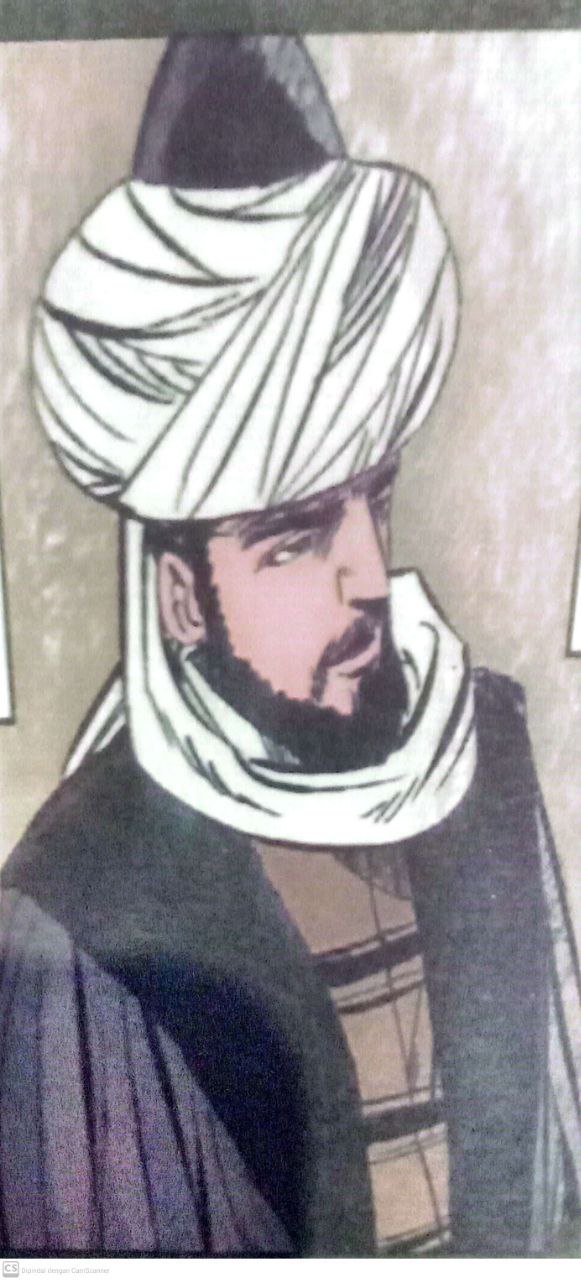
Hamza Pasha General Commander of the Turkiye-Venedik Fleet
On the other hand, the Venedic battles against Naples, Genoa, and Naples are still ongoing. The Naples ships had difficulty keeping their fleet formation. So Marco Quirini took this golden opportunity to close his ships with the Naples ships. Provveditore Venier ordered his ships to retreat for a while in order to draw the Venedic forces further away from their gallai and thus separate them from the Main Fleet. The ships of Naples fought back by advancing ahead of the Venedik fleet; one of its commanders, Girolamo Minotto, misinterpreted Provveditore Venier's signal to stay away, according to Satino, and attacked the Venedik flagship instead. Seeing the tactical failure of the Naples forces, the commander of the Venedik Galleries, Lorenzo Festa, laid siege to the Naples Fleet. while Gianpaolo Cavallo attacked the Li'solani Galleries to separate them.
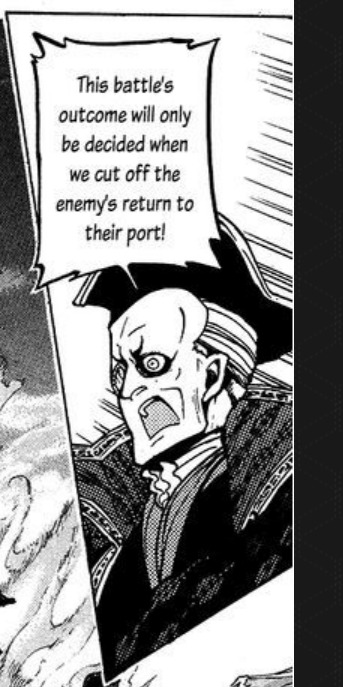
Marco Quirini commander of the venedic navy, who replaced Silvestro Brega.
Seeing the chaos in the formation of his battle fleet, Giustiniani tried to help by mobilising his remaining reserve ships. in order to release the blockade of the Venedik Force over the Naples troops. However, the Turkiye Galley, led by Hass Murad Pasha and Mesih Pasha, came from the side and intercepted the Genoa ships. The Genoa ships were able to match the Turkiye ships in battle by relying on the large size of their ships. thus being able to escape the interception. Venier himself was badly wounded by the many arrows that pierced him, feeling unable to continue the battle. He decided to withdraw his fleet and retreat. although the effort was quite impossible. However, Venier was able to make a feint with some of his crew by disguising himself as a common soldier and escaping with some of his ships that managed to escape the siege.
As a result, the Genoese and Rhodesians were left alone. This angered Giusitiniani. upset, he decided to return to Li'solani. hoping that he could avenge his painful defeat at the Sea of Phoenicia. This third Centro Sea battle lasted from dawn to sunset. The combined Turkiye-Venedik fleet was finally able to defeat the Crusader fleet. Many captains and crew members of enemy ships were killed and taken prisoner. and captured 57 galleys and 10 galleons, according to Satino's records. while the rest were destroyed during the battle. while the Egyptian historian, Maqrizi, says the number reached 40. Nicollo (one of the Venedik historians who participated in the war) details the ships captured by the Venedik forces. Lorenzo Festa captured 70 galleys belonging to Li'solani, while Marco Quirini captured 10 galleons belonging to Naples and one flagship galleon belonging to Genoa. The record of warships captured by the Turkiye is not mentioned by Nicollo except based on Maqrizi's account. The Turkiye captured 57 galleys, or at least 40 galleys, belonging to the Balt Rhein and 22 galleys belonging to Rhodes and Li'solani. Casualties on the Turkiye and Venedik sides reached at least 4000 men. on the enemy side, as narrated by Maqrizi, reached 30000 men. Most of the casualties were from the Balt Rhein.
Aftermath
Four days after the third Centro battle, Hamza Pasha and Quirini organised a pursuit of the fleeing Crusader fleet. The Turkiye-Venedik fleet approached the island of Crete and laid siege to Tarros and Ponente, which were the bases of the Balt Rhein Fleet's escape. After more than five days of siege, both cities were defeated. ending both city governments and entering into Turkiye domination. Hamza Pasha captured eight generals of the Balt Rhein superintendent and some resisting troops and executed them. Next, on the 27th, the Turkiye Venedik Fleet moved towards Li'solani through the Witch Straits to shorten the journey. Giustinianni had taken full command of the city's controls and taken Donatello Doria prisoner in his own palace, then prepared for the final battle.
On the 28th, fighting broke out again around Li'solani waters. The Genoese and Li'solani Fleets put up a vigorous resistance to the attacks of the Turkiye-Venedik Fleet, destroying parts of their galleys. Giustiniani tried to keep the enemy fleet away from the island, but was unsuccessful. Due to the unstable wind direction, the situation was reversed when the wind direction actually blew to the west, which brought the Genoese and Li'solani ships closer to land. The Turkiye-Venetian fleet took advantage of this opportunity by showering them with fire arrows in order to burn their ships and surrounded them. Giustiniani was forced to change his strategy by adopting defensive tactics in the fortress. The Turkiye troops carried out the siege from the 1st to the 6th of Raki. Li'solani decided to surrender. Despite Giustiniani's ingenuity, he was able to defend the city and thwart two consecutive attacks by the Turkiye-Venedik fleet. Due to the discontent of the inhabitants and merchants, they wanted the Genoese to withdraw from their city.
Hamza Pasha accompanied by the Janisaries entered the city on the 6th and ordered the troops to spread out, in search of Giustiniani. However, they did not find him. Most likely, Giustiniani had escaped with 700 of his troops by robbing some of Li'solani's Galleys and then returning to Italy. Hamza pasha then stormed Donatello's palace and arrested him while expressing his anger for betraying the Anti-Imperial Tripartite that had been agreed 3 years earlier. in return, Hamza Pasha placed Donatello's son, Antonio Doria as the new Li'solani ruler. signifying the end of the independence of the Li'solani government. and transformed into a Vassal state under the auspices of Turkiye.
The victory at Centro marked the beginning of the fledgling Turkiye naval supremacy that would continue to develop until the end of the Stratocracy and the return of the Ottoman Empire. Nicollo says that although the Turkiye lacked the quality of ships capable of matching the Venediks, Genoese, and Li'solani, and their ships were mostly small galleys, their rowers were adept at mobilising them according to the tide and wind direction. Hamza Pasha's strategy, docking fellow galleys until the transfer of rowing troops to enemy ships, and the ambush of the Genoese ship, which was in fact larger, made the Venedik commander, who witnessed the Turkiye way of war for the first time at sea, truly amazed. seen, several times the Turkiye troops applied the strategies of the Venedik troops themselves. One of them was pouring oil or soap on the enemy's deck to throw off their balance when moving. Or, the troops' shoes were coated with sand so that they could walk on the soap. Because of this, Nicollo commented, "This tribe of horsemen has learned something from us.".
According to Seth Perry, "the destruction of the Crusader Fleet at Centro emphasised the influence of Turkiye, this time not only dominating the land but also the sea. This was evidenced by the conquest of Tarros, Ponente, Li'solani, and finally Vessels. making Turkiye a major player in naval warfare. next to Venedik, Li'solani, and Genoa.
#shoukoku no altair#altair a record of battles#kotono kato#kato katono#navy#fanfic#fan fiction#ottoman#centro#zehir zaganos
3 notes
·
View notes
